
On your visit to Pondicherry, you will breathe in history and heritage, at every point, ranging from the remnants of an Ancient India to the stately colonial period. Every street and old building hails a rich cultural heritage. The city’s glamour is not just limited to its heritage landscapes and facades but also entails natural beauty: the expansive beaches, the forests and the lush gardens set a meditative ambiance. Find out what you must not miss!
French Institute
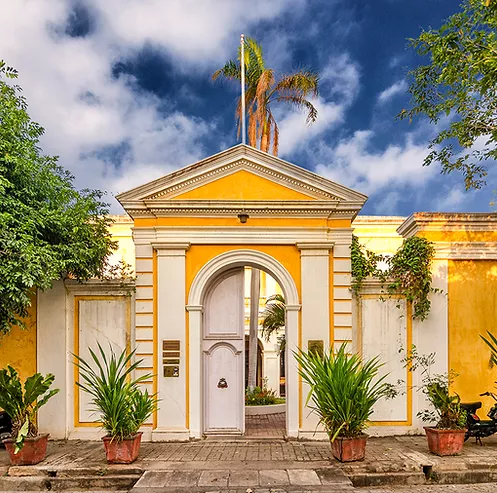 Established in 1955 as the"Institut Français d'Indologie, The French Institute of Pondicherry (Institut Français de Pondichéry) is an autonomous French institution under the French Ministry of Foreign and European Affairs (MAEE) and the French National Centre for Scientific Research (CNRS), dedicated to the study of Indian civilization and culture, especially the history and the religions of South India. In the 1960s, a department of ecology was set up for a detailed study of the Western Ghats, one of the world’s 34 hotspots for biodiversity. There is also a department of Social Sciences along with the Laboratory of Applied Informatics and Geomatics (LAGI).
The institute has three research libraries containing many niche books and primary research materials. The libraries are open to the curious and scholarly public.
Established in 1955 as the"Institut Français d'Indologie, The French Institute of Pondicherry (Institut Français de Pondichéry) is an autonomous French institution under the French Ministry of Foreign and European Affairs (MAEE) and the French National Centre for Scientific Research (CNRS), dedicated to the study of Indian civilization and culture, especially the history and the religions of South India. In the 1960s, a department of ecology was set up for a detailed study of the Western Ghats, one of the world’s 34 hotspots for biodiversity. There is also a department of Social Sciences along with the Laboratory of Applied Informatics and Geomatics (LAGI).
The institute has three research libraries containing many niche books and primary research materials. The libraries are open to the curious and scholarly public.
French War Memorial
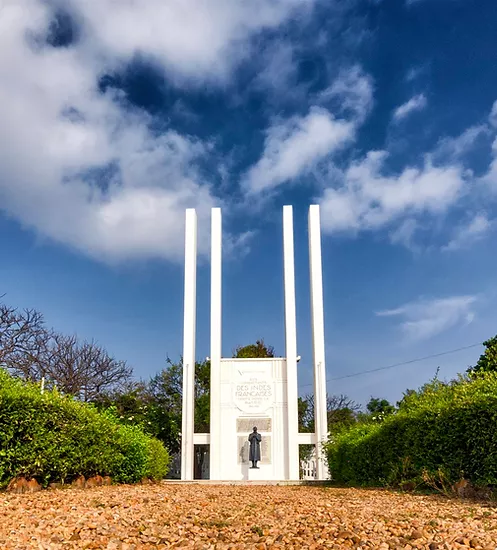 The memorial, erected on April 3, 1937, by governor Crociccha, is a tribute to the bravery of soldiers who had fought and lost their lives in the First World War. This monument immortalises the strong Indian presence in the World War for which homage is paid to those brave hearts on every Bastille Day as space is beautifully lit and decorated. Behind the memorial, there is also a bronze bas-relief representing the arrival of Dupleix in Pondicherry in 1742.
The memorial, erected on April 3, 1937, by governor Crociccha, is a tribute to the bravery of soldiers who had fought and lost their lives in the First World War. This monument immortalises the strong Indian presence in the World War for which homage is paid to those brave hearts on every Bastille Day as space is beautifully lit and decorated. Behind the memorial, there is also a bronze bas-relief representing the arrival of Dupleix in Pondicherry in 1742.
Gandhi Mandapam
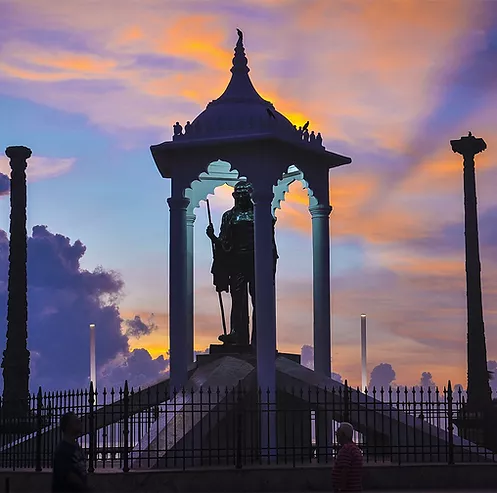 The Gandhi Statue is the most striking feature of the Promenade beach. Inaugurated on 26th January 1965, the statue is in honour of India’s Father of Nation, Mohandas Karamchand Gandhi, who played a major role in the Freedom Struggle by mobilising and leading the masses. This four-meter statue of Mahatma Gandhi is the tallest statue of Gandhi in Asia. It is surrounded by eight magnificent granite pillars, which were brought from Gingee a fort some 70 km from Pondicherry.
On Gandhi’s birthday, 2 October, respects are paid at the statue; many other national holidays such as Independence Day and Republic Day are celebrated near the statue.
The square in front of the statue, referred to as Gandhi Thidal, plays host to various cultural, musical, and commercial activities throughout the year.
The Gandhi Statue is the most striking feature of the Promenade beach. Inaugurated on 26th January 1965, the statue is in honour of India’s Father of Nation, Mohandas Karamchand Gandhi, who played a major role in the Freedom Struggle by mobilising and leading the masses. This four-meter statue of Mahatma Gandhi is the tallest statue of Gandhi in Asia. It is surrounded by eight magnificent granite pillars, which were brought from Gingee a fort some 70 km from Pondicherry.
On Gandhi’s birthday, 2 October, respects are paid at the statue; many other national holidays such as Independence Day and Republic Day are celebrated near the statue.
The square in front of the statue, referred to as Gandhi Thidal, plays host to various cultural, musical, and commercial activities throughout the year.
Immaculate Church
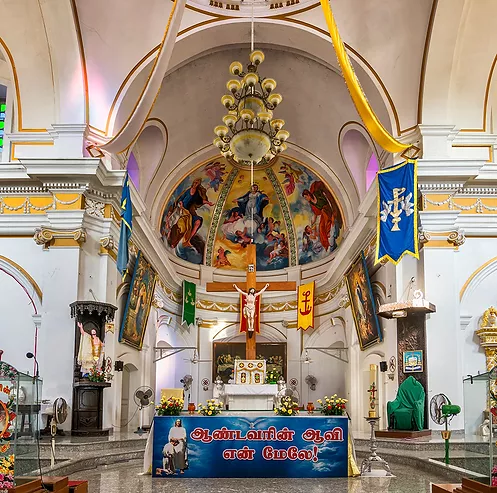 Immaculate Conception Cathedral is one of the most important churches in Pondicherry and Cuddalore. Located on Mission Street, this cathedral was built in 1791 on the ruins of an older church which was destroyed several times due to skirmishes arising from complex 17th and 18th-century colony politics between the British, the Dutch, and the French.
The entrance with a grand gate and the statue of Madonna with a child in the courtyard make an awe-inspiring sight. The facade has Doric columns, giving the cathedral a regal appearance. The interior design consists of eight barrel vaults and a central dome pierced with eight circular openings. The cathedral is noteworthy for its crowded masses and the countless footfalls of people admiring the architectural beauty of the cathedral.
Being a major Christian religious institution, the Immaculate Conception Cathedral was visited by Mother Teresa during her visit to Puducherry.
Immaculate Conception Cathedral is one of the most important churches in Pondicherry and Cuddalore. Located on Mission Street, this cathedral was built in 1791 on the ruins of an older church which was destroyed several times due to skirmishes arising from complex 17th and 18th-century colony politics between the British, the Dutch, and the French.
The entrance with a grand gate and the statue of Madonna with a child in the courtyard make an awe-inspiring sight. The facade has Doric columns, giving the cathedral a regal appearance. The interior design consists of eight barrel vaults and a central dome pierced with eight circular openings. The cathedral is noteworthy for its crowded masses and the countless footfalls of people admiring the architectural beauty of the cathedral.
Being a major Christian religious institution, the Immaculate Conception Cathedral was visited by Mother Teresa during her visit to Puducherry.
Jamia Mosque
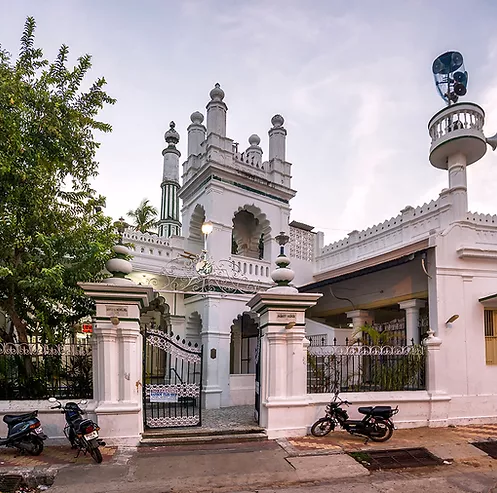 It is believed that the Khuthbha Mosque, also referred to as Khuthbhapalli, was built before the colonial times in Ponidcherry, around the 17th century, and is speculated to be the oldest mosque in Pondicherry. The mosque stands as a reminder of the long-standing religious diversity of the town. It was initially built at the present location of the Seventh Day School but under French rule, order for the mosque to be built in the Southern end of Pondicherry along with the shifting of the whole Muslim community was issued. The mosque is an important place of worship in Pondicherry and hosts regular prayers. The Dargah of Mollu Saiubu is part of the mosque.
It is believed that the Khuthbha Mosque, also referred to as Khuthbhapalli, was built before the colonial times in Ponidcherry, around the 17th century, and is speculated to be the oldest mosque in Pondicherry. The mosque stands as a reminder of the long-standing religious diversity of the town. It was initially built at the present location of the Seventh Day School but under French rule, order for the mosque to be built in the Southern end of Pondicherry along with the shifting of the whole Muslim community was issued. The mosque is an important place of worship in Pondicherry and hosts regular prayers. The Dargah of Mollu Saiubu is part of the mosque.
Joan of Arc
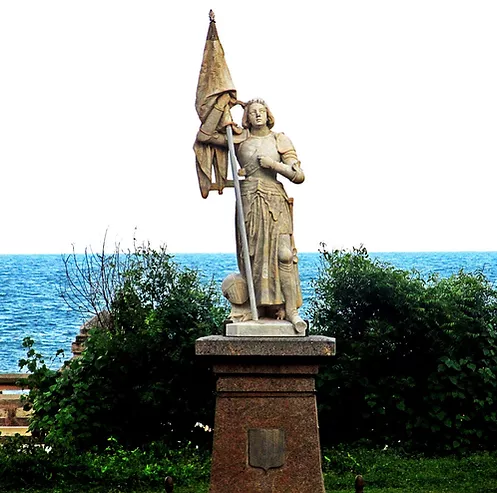 Jeanne d'Arc or Joan of Arc is the very embodiment of courage and righteousness and was posthumously canonised for her saintly nature and courage in 1920 and declared one of the nine secondary patron saints of France. Her name is etched in history for guiding Charles VII in the Hundred Years War. Three years after her canonisation, Francois Gaudart who was the mayor of Pondicherry commissioned a statue of Joan of Arc. A marble statue of the saint is located in front of the Church of Our Lady of the Angels, in the middle of a garden. The statue celebrates not only the Indo-French heritage of Pondicherry but her courage.
From the beach, the statue against the pastel colours of the church and the orange and purple twilight sky makes one of the most magical sights in Pondicherry.
Jeanne d'Arc or Joan of Arc is the very embodiment of courage and righteousness and was posthumously canonised for her saintly nature and courage in 1920 and declared one of the nine secondary patron saints of France. Her name is etched in history for guiding Charles VII in the Hundred Years War. Three years after her canonisation, Francois Gaudart who was the mayor of Pondicherry commissioned a statue of Joan of Arc. A marble statue of the saint is located in front of the Church of Our Lady of the Angels, in the middle of a garden. The statue celebrates not only the Indo-French heritage of Pondicherry but her courage.
From the beach, the statue against the pastel colours of the church and the orange and purple twilight sky makes one of the most magical sights in Pondicherry.
Le Cafe
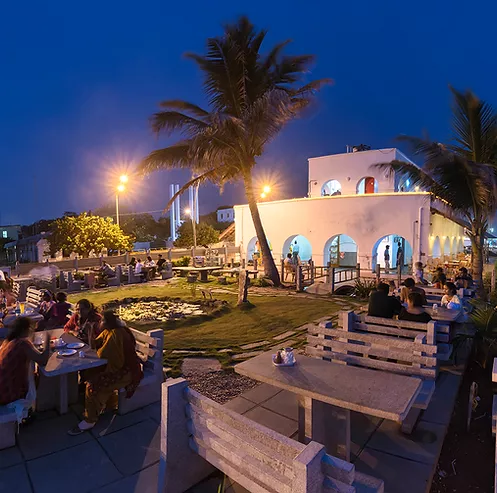 Open round the clock, Le Café is the perfect spot to beat the heat when one gets tired and hungry during a walk on the Promenade Beach. The building was initially the port office when the railway ran on the Beach Road from the South Boulevard to the pier. The pier was destroyed in 1952 during a cyclone. The destroyed pier still juts into the blue sea, making a thin black line on a blue canvas.
The café serves refreshing beverages ideal for Pondicherry’s climate along with freshly baked dishes. You can dig into your quiche or pasta as you watch the magnificent Bay of Bengal and the waves break on the mossy rocks- it is this view that sets the café apart from the others in town. When the café gets quiet, the proximity of the sea and the sound of the wave give the impression of being in the sea.
Open round the clock, Le Café is the perfect spot to beat the heat when one gets tired and hungry during a walk on the Promenade Beach. The building was initially the port office when the railway ran on the Beach Road from the South Boulevard to the pier. The pier was destroyed in 1952 during a cyclone. The destroyed pier still juts into the blue sea, making a thin black line on a blue canvas.
The café serves refreshing beverages ideal for Pondicherry’s climate along with freshly baked dishes. You can dig into your quiche or pasta as you watch the magnificent Bay of Bengal and the waves break on the mossy rocks- it is this view that sets the café apart from the others in town. When the café gets quiet, the proximity of the sea and the sound of the wave give the impression of being in the sea.
Legislative Assembly
 The Assembly building is situated in the public square where important buildings have stood since the French era. These buildings were built flamboyant and imposing to signify their importance in the town. These buildings mark major milestones in the history of Pondicherry.
The former residence of a certain Mr. Pernon, the Assembly building has a classic colonial architecture with circular rooms on the front facade with an elevated portico, grand flight of stairs, and traditional terracotta hand balusters. The staircase leads to the colonnaded portico with round masonry. It also had grand French windows with pillars in between. Apart from the history that the building represents, in the building the political history of Pondicherry is written with every assembly meeting.
Since 1969, the Assembly sessions have been conducted in this building.
The Assembly building is situated in the public square where important buildings have stood since the French era. These buildings were built flamboyant and imposing to signify their importance in the town. These buildings mark major milestones in the history of Pondicherry.
The former residence of a certain Mr. Pernon, the Assembly building has a classic colonial architecture with circular rooms on the front facade with an elevated portico, grand flight of stairs, and traditional terracotta hand balusters. The staircase leads to the colonnaded portico with round masonry. It also had grand French windows with pillars in between. Apart from the history that the building represents, in the building the political history of Pondicherry is written with every assembly meeting.
Since 1969, the Assembly sessions have been conducted in this building.
Manakula Vinayagar
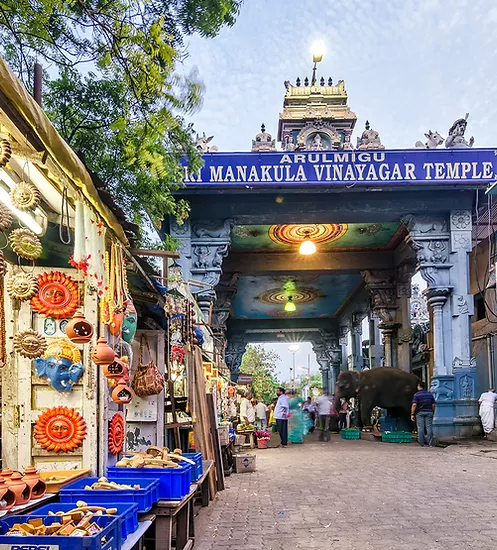 Known to fulfill one’s wishes, the main deity of the Mankula Vinayagar Temple is Lord Ganesha. The temple dates back to 300 hundred years. Intricate statues adorn the exterior of the temple and detailed depictions of mythological chapters about Ganesh lead to the sanctum sanctorum where a majestic bejeweled idol gleams in the lamps lit in its honour. The temple has miniature shrines along with that of Lord Murugan, the brother of Ganesh.
During French rule, there were attempts to destroy the temple but the protests from the local Hindus made it impossible. A story also goes that previously the temple being much smaller, there was less space for the devotees to do ‘parikrama’, so Ganesh asked the Mother (Sri Aurobindo Ashram) to buy and donate land around the temple.
Due to the many myths around the deity, devotees throng to seek blessings at this temple, especially on festivals such as Vinayagar Chaturthi.
Known to fulfill one’s wishes, the main deity of the Mankula Vinayagar Temple is Lord Ganesha. The temple dates back to 300 hundred years. Intricate statues adorn the exterior of the temple and detailed depictions of mythological chapters about Ganesh lead to the sanctum sanctorum where a majestic bejeweled idol gleams in the lamps lit in its honour. The temple has miniature shrines along with that of Lord Murugan, the brother of Ganesh.
During French rule, there were attempts to destroy the temple but the protests from the local Hindus made it impossible. A story also goes that previously the temple being much smaller, there was less space for the devotees to do ‘parikrama’, so Ganesh asked the Mother (Sri Aurobindo Ashram) to buy and donate land around the temple.
Due to the many myths around the deity, devotees throng to seek blessings at this temple, especially on festivals such as Vinayagar Chaturthi.
Meeran Mosque
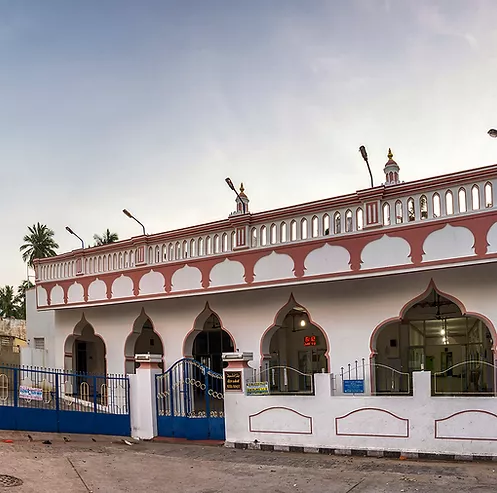 Built more than three hundred years ago by the Arcot Nawabs, Meera Mosque, also known locally as the Meerapalli, is a beautiful Gothic Islamic style structure and the second oldest mosque in Pondicherry. The mosque is not only a major religious site for the Muslim community. The mosque is a fine example of varied influences in the cultural history of the region. The mosque also houses the graves of Meeran, the one who built the mosque, and of Suubhi Errai Perriar Mullah.
Built more than three hundred years ago by the Arcot Nawabs, Meera Mosque, also known locally as the Meerapalli, is a beautiful Gothic Islamic style structure and the second oldest mosque in Pondicherry. The mosque is not only a major religious site for the Muslim community. The mosque is a fine example of varied influences in the cultural history of the region. The mosque also houses the graves of Meeran, the one who built the mosque, and of Suubhi Errai Perriar Mullah.
Ousteri Lake
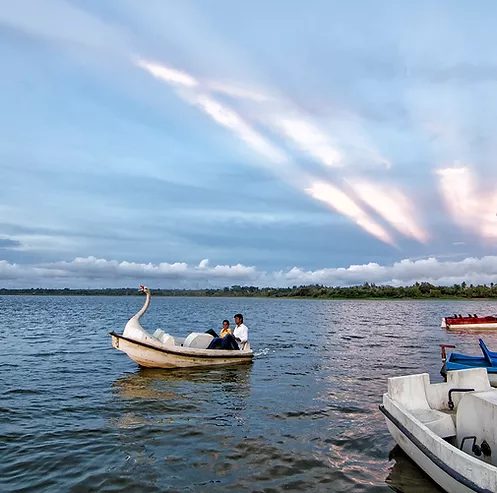 Ousteri Lake is a place of true wonders. Surrounded by an afforested area that is now dense and lush, the lake once was made artificially by the French. It is now home to diverse life forms. The lake was recently declared a wildlife sanctuary and is recognised to be one of the important wetlands of Asia by the International Union for Conservation of Nature and Natural Resources. This sanctuary is proof of can achieve when in unison with nature. The long stretches of lotuses, birds skimming the lake, and the array of greenery make the perfect eco-tourism spot. The sanctuary is home to a wide range of birds such as Spot-billed Pelicans, Eurasian Spoonbills, and Ibis. The best time to visit Ousteri Lake is between October and March. One can have a merry time boating on the lake, a facility provided by the Pondicherry Tourism Department. In the lap of nature, you may discover hidden aspects of yourself.
Ousteri Lake is a place of true wonders. Surrounded by an afforested area that is now dense and lush, the lake once was made artificially by the French. It is now home to diverse life forms. The lake was recently declared a wildlife sanctuary and is recognised to be one of the important wetlands of Asia by the International Union for Conservation of Nature and Natural Resources. This sanctuary is proof of can achieve when in unison with nature. The long stretches of lotuses, birds skimming the lake, and the array of greenery make the perfect eco-tourism spot. The sanctuary is home to a wide range of birds such as Spot-billed Pelicans, Eurasian Spoonbills, and Ibis. The best time to visit Ousteri Lake is between October and March. One can have a merry time boating on the lake, a facility provided by the Pondicherry Tourism Department. In the lap of nature, you may discover hidden aspects of yourself.
Light House
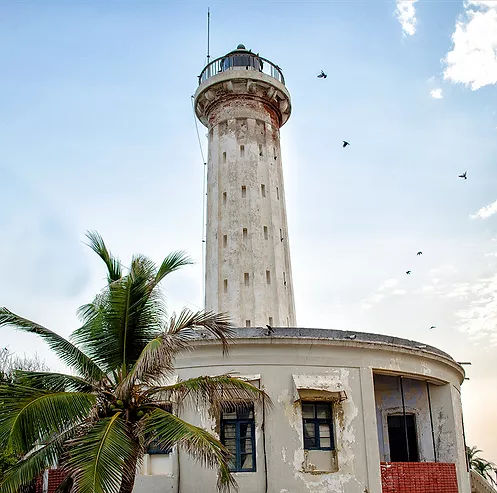 The Old light House is one of the most prominent features of the Promenade Beach, dating back to the 19th century. In the initial days of the French colony, the navigators only had the Red Hills, about 3 km west of Pondicherry as a landmark. To provide a steady landmark for the ships, this lighthouse was built in 1836. Till 1970 the lighthouse continued to function until the erection of a new lighthouse south of town. The lighthouse is now an iconic vestige of French rule and has been converted partly into a museum.
The Old light House is one of the most prominent features of the Promenade Beach, dating back to the 19th century. In the initial days of the French colony, the navigators only had the Red Hills, about 3 km west of Pondicherry as a landmark. To provide a steady landmark for the ships, this lighthouse was built in 1836. Till 1970 the lighthouse continued to function until the erection of a new lighthouse south of town. The lighthouse is now an iconic vestige of French rule and has been converted partly into a museum.
Paradise Beach
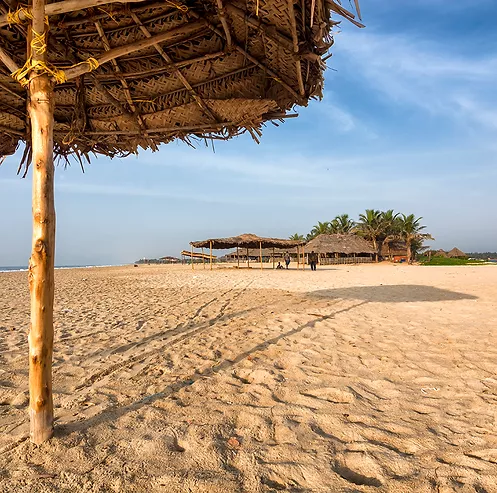 The picturesque Paradise Beach is a private beach located on the Cuddalore Main Road, 8 km away from Pondicherry. Ferry services from the Chunnambar Boat House are the only way to visit Paradise Beach. The beautiful white sand and the crystal blue water make a true paradise to laze around and soak in the beauty. If you can’t resist the waters, you can swim close to the shore as the currents are strong further. You can lounge on the easy chairs kept at the beach or play beach sports with your companions. As you get tired, retire to the restaurant shack for fresh food and cool drinks.
The restaurant serves a variety of cuisines whose wafting aroma in the cool sea breeze will make your mouth water. The delicious meal with the breathtaking view is bound to leave a mark on you.
The picturesque Paradise Beach is a private beach located on the Cuddalore Main Road, 8 km away from Pondicherry. Ferry services from the Chunnambar Boat House are the only way to visit Paradise Beach. The beautiful white sand and the crystal blue water make a true paradise to laze around and soak in the beauty. If you can’t resist the waters, you can swim close to the shore as the currents are strong further. You can lounge on the easy chairs kept at the beach or play beach sports with your companions. As you get tired, retire to the restaurant shack for fresh food and cool drinks.
The restaurant serves a variety of cuisines whose wafting aroma in the cool sea breeze will make your mouth water. The delicious meal with the breathtaking view is bound to leave a mark on you.
PWD
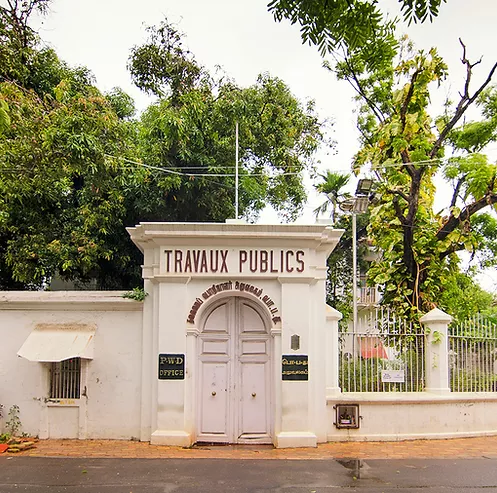 The Public Works Department is housed in an imposing colonial building with a grand entrance, tall compound walls, arched windows, and ironwork on windows and balconies. On this location, there was the Hotel de la Monnaie, built between 1736 and 1738 and destroyed in 1761. The building rebuilt in 1766 was used in 1884 as the Bibliotheque Publique and Bureau des Ponts et Chaussees. Since 1954, the building has hosted the Bureau des Travaux Publics (Public Works Department) and has been carrying out Planning, Designing, Construction and Maintenance of Buildings, Roads, Bridges, National Highways, Irrigation, Flood Control, Water Supply and Public Health Engineering in all the four regions of Pondicherry: Puducherry, Karaikal, Mahe, and Yanam
The Public Works Department is housed in an imposing colonial building with a grand entrance, tall compound walls, arched windows, and ironwork on windows and balconies. On this location, there was the Hotel de la Monnaie, built between 1736 and 1738 and destroyed in 1761. The building rebuilt in 1766 was used in 1884 as the Bibliotheque Publique and Bureau des Ponts et Chaussees. Since 1954, the building has hosted the Bureau des Travaux Publics (Public Works Department) and has been carrying out Planning, Designing, Construction and Maintenance of Buildings, Roads, Bridges, National Highways, Irrigation, Flood Control, Water Supply and Public Health Engineering in all the four regions of Pondicherry: Puducherry, Karaikal, Mahe, and Yanam
Raj Nivas
 The architecture of the Government House (Raj Nivas) is a harmonious blend of French and Indian styles. The architecture is representative of the various historical events carried out in Pondicherry out of this very location. The building was been home to the powerful and ruling class and the centre of power since the 18th century starting from the time when it was called the Hotel de la Compagnie of the French trading company to hosting Dupleix and his successors. It is now the Lieutenant Governor's residence.
Two imposing statues of guards beside the gate, the carefully manicured garden, monolithic pillars from Gingee, and the sprawling building come together in a regal ensemble befitting the authority and power of the building houses.
Raj Nivas is open to the general public except on national holidays such as Republic Day on 26th January, when it is elaborately decorated with lights.
The architecture of the Government House (Raj Nivas) is a harmonious blend of French and Indian styles. The architecture is representative of the various historical events carried out in Pondicherry out of this very location. The building was been home to the powerful and ruling class and the centre of power since the 18th century starting from the time when it was called the Hotel de la Compagnie of the French trading company to hosting Dupleix and his successors. It is now the Lieutenant Governor's residence.
Two imposing statues of guards beside the gate, the carefully manicured garden, monolithic pillars from Gingee, and the sprawling building come together in a regal ensemble befitting the authority and power of the building houses.
Raj Nivas is open to the general public except on national holidays such as Republic Day on 26th January, when it is elaborately decorated with lights.
Rock Beach
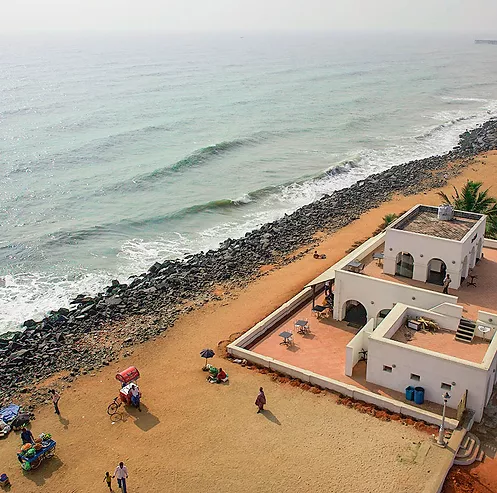 Promenade beach lives up to its name as it is flooded by a crowd of joggers and walkers every morning and evening. This stretch of 1.5 km is the most iconic site of Pondicherry. During the walks here one can also visit a host of monuments and landmarks that line the beach such as the statue of Joan of Arc, the town hall, the stately tourist information centre, the War memorial, and the centerpiece of the landscape, the Gandhi statue. But none of these monuments attract as many people as the sea does; people sit on the rocks and gaze for hours at the crashing waves and the frothing sea.
As you walk on the beach you can pick up popcorn, chaat, or snacks whose aroma fills the air. There are also a host of amazing restaurants on the beach where you can unwind. No trip to Pondicherry is complete without visiting the Promenade Beach.
Promenade beach lives up to its name as it is flooded by a crowd of joggers and walkers every morning and evening. This stretch of 1.5 km is the most iconic site of Pondicherry. During the walks here one can also visit a host of monuments and landmarks that line the beach such as the statue of Joan of Arc, the town hall, the stately tourist information centre, the War memorial, and the centerpiece of the landscape, the Gandhi statue. But none of these monuments attract as many people as the sea does; people sit on the rocks and gaze for hours at the crashing waves and the frothing sea.
As you walk on the beach you can pick up popcorn, chaat, or snacks whose aroma fills the air. There are also a host of amazing restaurants on the beach where you can unwind. No trip to Pondicherry is complete without visiting the Promenade Beach.
Romain Rolland Library
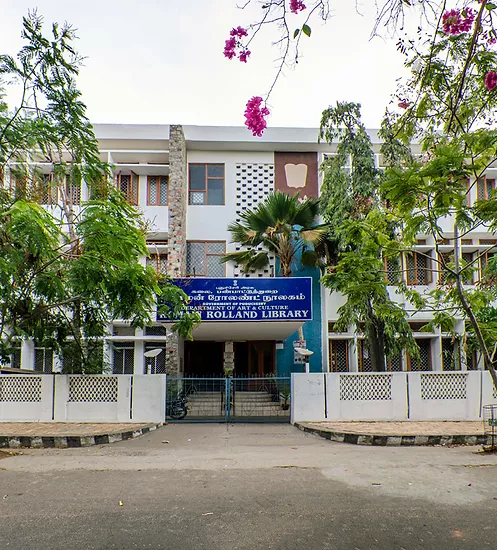 The library was opened on 16 May 1827, the library was opened by Desbassyns de Richemont, and was housed within the P.W.D building till it was transferred to Rue des Capucins (Romain Rolland Street). Previously known as 'Bibliotheque Publique', it is one of the oldest libraries in the country and the biggest in the Union Territory In the first ten years the entry of the natives was restricted. Only after 1837, the local population was allowed in the library so that they could learn French and be integrated into the clerical class. In August 1967 the library was named after Roman Rolland, a renowned French scholar and popular among many eminent Indians of the time such as Mahatma Gandhi. In 1974, the library was brought to the current location, beside the Raj Nivas.
The Romain Rolland library, now has a rich collection of more than 3, 00,000 volumes of books both in French, English, and Tamil. There is also a dedicated children’s wing in the library.
The library was opened on 16 May 1827, the library was opened by Desbassyns de Richemont, and was housed within the P.W.D building till it was transferred to Rue des Capucins (Romain Rolland Street). Previously known as 'Bibliotheque Publique', it is one of the oldest libraries in the country and the biggest in the Union Territory In the first ten years the entry of the natives was restricted. Only after 1837, the local population was allowed in the library so that they could learn French and be integrated into the clerical class. In August 1967 the library was named after Roman Rolland, a renowned French scholar and popular among many eminent Indians of the time such as Mahatma Gandhi. In 1974, the library was brought to the current location, beside the Raj Nivas.
The Romain Rolland library, now has a rich collection of more than 3, 00,000 volumes of books both in French, English, and Tamil. There is also a dedicated children’s wing in the library.
Sacred Church
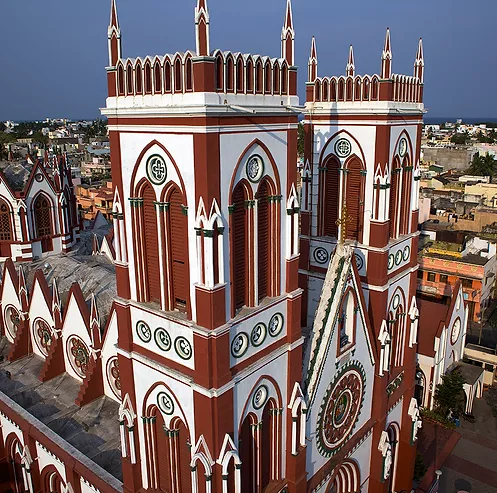 This breathtaking Neo-Gothic church was built in the 18th century by French missionaries. The church is one of the best specimens of old and rich architecture that Pondicherry celebrates. There is a sense of awe invoked as one looks at the large entrance and the central gable with stained glass of the church depicting multiple instants of the life of Christ. The church is popular among the Catholic community. It is located on the Subbaih Salai. The current structure was built in 1908 with constant changes being made hence.
It would also be intriguing to look at the ornate marble decorations on the tombs in the cemetery, along the south boulevard.
This breathtaking Neo-Gothic church was built in the 18th century by French missionaries. The church is one of the best specimens of old and rich architecture that Pondicherry celebrates. There is a sense of awe invoked as one looks at the large entrance and the central gable with stained glass of the church depicting multiple instants of the life of Christ. The church is popular among the Catholic community. It is located on the Subbaih Salai. The current structure was built in 1908 with constant changes being made hence.
It would also be intriguing to look at the ornate marble decorations on the tombs in the cemetery, along the south boulevard.
Lycee Francaise
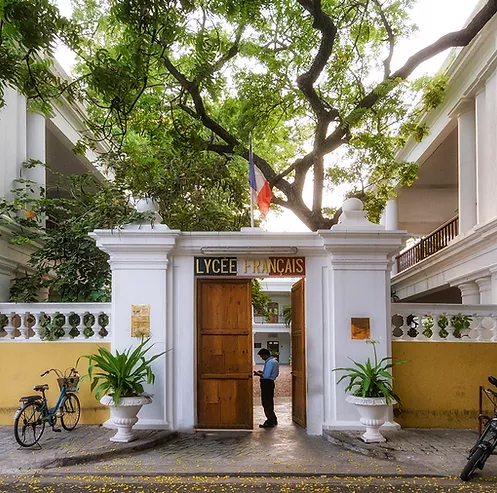 The Lycee Francaise is the oldest French school in Asia and the second largest in the continent. Established in 1826 as the College Royal, the school offers a top-notch, comprehensive, French medium education from Pre-Primary school to the final year of Secondary school with general, technical, and professional options. In the curriculum, there is a special emphasis on learning English and Tamil or the regional languages. The courses held at the Lycee are set by the French Ministry Of Education and therefore the students receive premium education of France sitting in Pondicherry. The alumni of the school often receive several enviable opportunities in India, France, and across the globe.
The school being a part of the town for so long is an important part of its heritage. It has an intriguing collection of old photographs of colonial Puducherry and a collection of very rare coins of the French East Indian Company.
The Lycee Francaise is the oldest French school in Asia and the second largest in the continent. Established in 1826 as the College Royal, the school offers a top-notch, comprehensive, French medium education from Pre-Primary school to the final year of Secondary school with general, technical, and professional options. In the curriculum, there is a special emphasis on learning English and Tamil or the regional languages. The courses held at the Lycee are set by the French Ministry Of Education and therefore the students receive premium education of France sitting in Pondicherry. The alumni of the school often receive several enviable opportunities in India, France, and across the globe.
The school being a part of the town for so long is an important part of its heritage. It has an intriguing collection of old photographs of colonial Puducherry and a collection of very rare coins of the French East Indian Company.
Sri Aurobindo Aashram
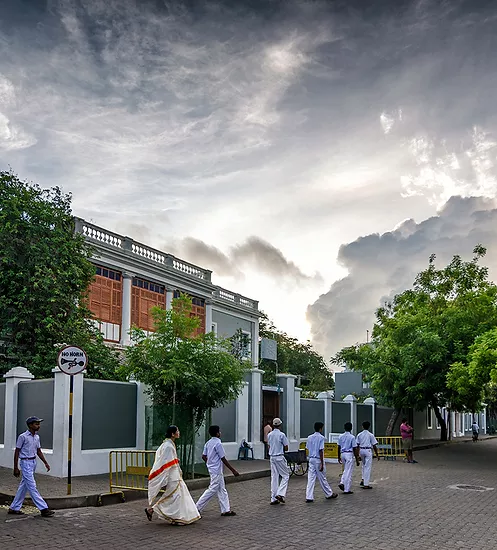 The Sri Aurobindo Ashram, located on Rue de la Marine was founded by Sri Aurobindo and the Mother in 1926 for those who sought the spiritual life and were drawn by their philosophy. The Ashram mainly refers to the main Ashram building where the Samadhi (mausoleum) of both the spiritual leaders is. The institution has facilities all around the town; these buildings are gray and often have a distinct appearance, adding to the city a unique flavor. While a lot of the facilities are private but along with visiting the Samadhi, the visitors are allowed to visit some facilities and even be on tour around the facilities and get a glimpse of the life in the Ashram.
Sri Aurobindo Ashram is not only a unique spiritual institution of great importance but also is a melting pot of several nationalities, identities, and cultures as devotees across the globe visit the Ashram.
The Sri Aurobindo Ashram, located on Rue de la Marine was founded by Sri Aurobindo and the Mother in 1926 for those who sought the spiritual life and were drawn by their philosophy. The Ashram mainly refers to the main Ashram building where the Samadhi (mausoleum) of both the spiritual leaders is. The institution has facilities all around the town; these buildings are gray and often have a distinct appearance, adding to the city a unique flavor. While a lot of the facilities are private but along with visiting the Samadhi, the visitors are allowed to visit some facilities and even be on tour around the facilities and get a glimpse of the life in the Ashram.
Sri Aurobindo Ashram is not only a unique spiritual institution of great importance but also is a melting pot of several nationalities, identities, and cultures as devotees across the globe visit the Ashram.
Thiru Kameshwarar
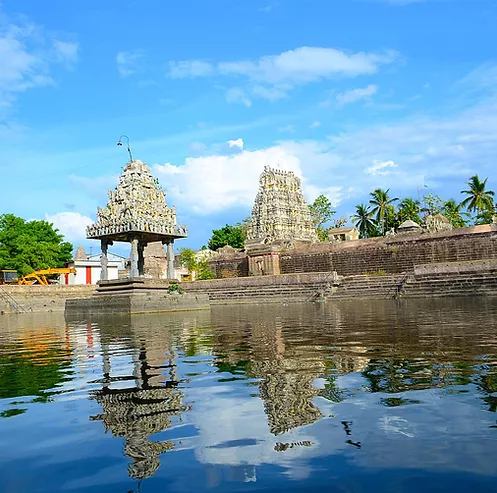 Dedicated to the principal deity, Lord Shiva, Sri Gokilambal Thirukameshwar Temple is situated near Villianur, 11 km from Pondicherry. The temple dates back to the Chola period and flaunts a grand traditional structure. What differentiates this ancient temple from others across the country, is the French influence in the traditions and rituals of the temple. The temple experiences crowd throughout the year but there is a deluge of devotees, during the annual Temple Car Festival, who come to pull a 15 metre tall chariot as a form of worship; it is believed that if one pulls the chariots one’s prayers are granted by the deity. The festival is celebrated around May and June with much extravagance.
Dedicated to the principal deity, Lord Shiva, Sri Gokilambal Thirukameshwar Temple is situated near Villianur, 11 km from Pondicherry. The temple dates back to the Chola period and flaunts a grand traditional structure. What differentiates this ancient temple from others across the country, is the French influence in the traditions and rituals of the temple. The temple experiences crowd throughout the year but there is a deluge of devotees, during the annual Temple Car Festival, who come to pull a 15 metre tall chariot as a form of worship; it is believed that if one pulls the chariots one’s prayers are granted by the deity. The festival is celebrated around May and June with much extravagance.
Veda Pureeswarar Temple
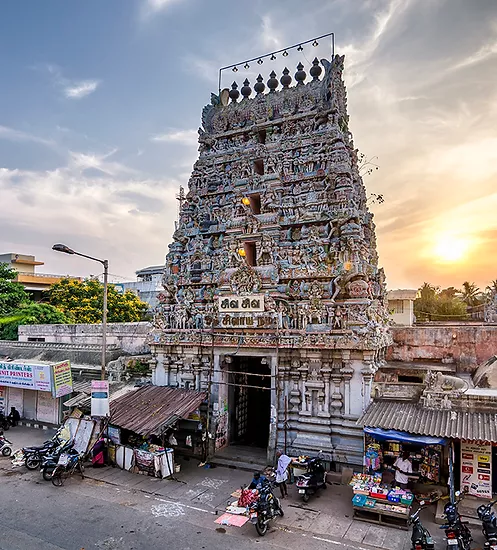 Popularly known as the Eashwaran Koil, the Vedhapureeswara Temple is consecrated to the worship of Lord Shiva. Majestically towering over the busy Mahatma Gandhi Road, the colourful ‘gopuram’ tells countless stories from Hindu mythology. This beautiful temple is a fine example of a classic South Indian Temple and a must-visit. The temple always has a crowd of devotees, especially on auspicious days.
In 1748, during Governor Dupleix's rule, the original temple - Vedapuri Iswaran Koil - was destroyed but rebuilt by Dubash Kandappa Mudaliar around 1788.
According to local legend, the idol worshipped is 'swayambu Linga' – meaning it materialised on its own in its current form. The idol was shifted to this temple from the Mission Street Samba Easwaran Temple 100 years ago. There is a special temple for Lord Dakshinamurthy within this temple premises along with the shrine of Lord Muruga whose adulations were sung by Sri Ramalinga Swamigal in his hymns.
Popularly known as the Eashwaran Koil, the Vedhapureeswara Temple is consecrated to the worship of Lord Shiva. Majestically towering over the busy Mahatma Gandhi Road, the colourful ‘gopuram’ tells countless stories from Hindu mythology. This beautiful temple is a fine example of a classic South Indian Temple and a must-visit. The temple always has a crowd of devotees, especially on auspicious days.
In 1748, during Governor Dupleix's rule, the original temple - Vedapuri Iswaran Koil - was destroyed but rebuilt by Dubash Kandappa Mudaliar around 1788.
According to local legend, the idol worshipped is 'swayambu Linga' – meaning it materialised on its own in its current form. The idol was shifted to this temple from the Mission Street Samba Easwaran Temple 100 years ago. There is a special temple for Lord Dakshinamurthy within this temple premises along with the shrine of Lord Muruga whose adulations were sung by Sri Ramalinga Swamigal in his hymns.
Vysial Street
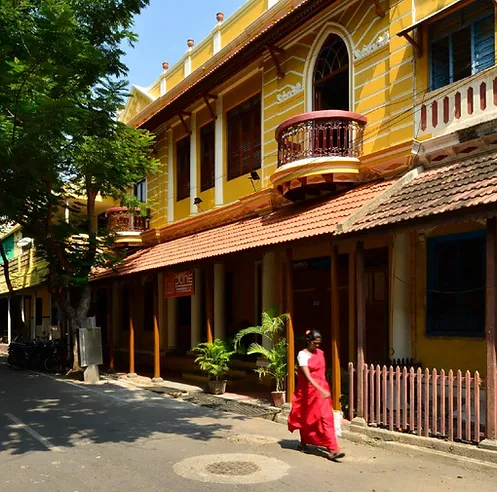 Declared as a UNESCO Heritage site in 2008, Vysial Street is one of the rare locations in Pondicherry where still old houses with the earliest examples of fusion between European and Tamil architecture can be seen. The houses here are about 250 years old and still preserve their original beauty. The unique features of the architecture of these houses are the ‘thinnai’, a flat-ceiling platform built into the facade and supported by large wooden columns, the 'mutram', a central open courtyard surrounded by a colonnaded roofed space, and the 'thalvaram', a tiled roof extending from the sloping roof to posts or pillars at the curb, sheltered people from intense rain or shine.
Declared as a UNESCO Heritage site in 2008, Vysial Street is one of the rare locations in Pondicherry where still old houses with the earliest examples of fusion between European and Tamil architecture can be seen. The houses here are about 250 years old and still preserve their original beauty. The unique features of the architecture of these houses are the ‘thinnai’, a flat-ceiling platform built into the facade and supported by large wooden columns, the 'mutram', a central open courtyard surrounded by a colonnaded roofed space, and the 'thalvaram', a tiled roof extending from the sloping roof to posts or pillars at the curb, sheltered people from intense rain or shine.
© Bonjour Media. All Rights Reserved.